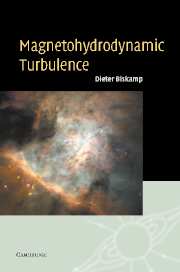Book contents
- Frontmatter
- Contents
- Preface
- 1 Introduction
- 2 Magnetohydrodynamics
- 3 Transition to turbulence
- 4 Macroscopic turbulence theory
- 5 Spectral properties and phenomenology
- 6 Two-point-closure theory
- 7 Intermittency
- 8 Two-dimensional turbulence
- 9 Compressible turbulence and turbulent convection
- 10 Turbulence in the solar wind
- 11 Turbulence in accretion disks
- 12 Interstellar turbulence
- Outlook
- References
- Index
7 - Intermittency
Published online by Cambridge University Press: 17 August 2009
- Frontmatter
- Contents
- Preface
- 1 Introduction
- 2 Magnetohydrodynamics
- 3 Transition to turbulence
- 4 Macroscopic turbulence theory
- 5 Spectral properties and phenomenology
- 6 Two-point-closure theory
- 7 Intermittency
- 8 Two-dimensional turbulence
- 9 Compressible turbulence and turbulent convection
- 10 Turbulence in the solar wind
- 11 Turbulence in accretion disks
- 12 Interstellar turbulence
- Outlook
- References
- Index
Summary
Turbulence is usually associated with the idea of self-similarity, which means that the spatial distribution of the turbulent eddies looks the same on any scale level in the inertial range. This is a basic assumption in the Kolmogorov phenomenology K41 and, on the same lines, the IK phenomenology introduced in Section 5.3.2. It is, however, well known that this picture is not exactly true, since it ignores the existence of small-scale structures, which cannot be distributed in a uniform space-filling way. In fact, in a real turbulence field experiments as well as numerical simulations show that smaller eddies, or higher frequencies, become increasingly sparse, or intermittent, which apparently violates self-similarity. This chapter deals with the various aspects of intermittency.
Section 7.1 gives a brief introduction. We illustrate the concept of self-similarity by some simple examples and clarify the notion of intermittency, distinguishing between dissipation-range and inertial-range intermittency. Section 7.2 deals with structure functions, in particular the set of inertial-range scaling exponents, which are convenient parameters for a quantitative description of the statistical distribution of the turbulence scales. We discuss the important constraints on these exponents imposed by basic probabilistic requirements. Since experiments and, even more so, numerical simulations deal with turbulence of finite, often rather low, Reynolds number, the scaling range may be quite short, or even hardly discernable, especially for higher-order structure functions, which makes determination of the scaling exponents difficult. The scaling properties can, however, be substantially improved by making use of the extended self-similarity (ESS), which often provides surprisingly accurate values of the relative scaling exponents.
- Type
- Chapter
- Information
- Magnetohydrodynamic Turbulence , pp. 131 - 160Publisher: Cambridge University PressPrint publication year: 2003



